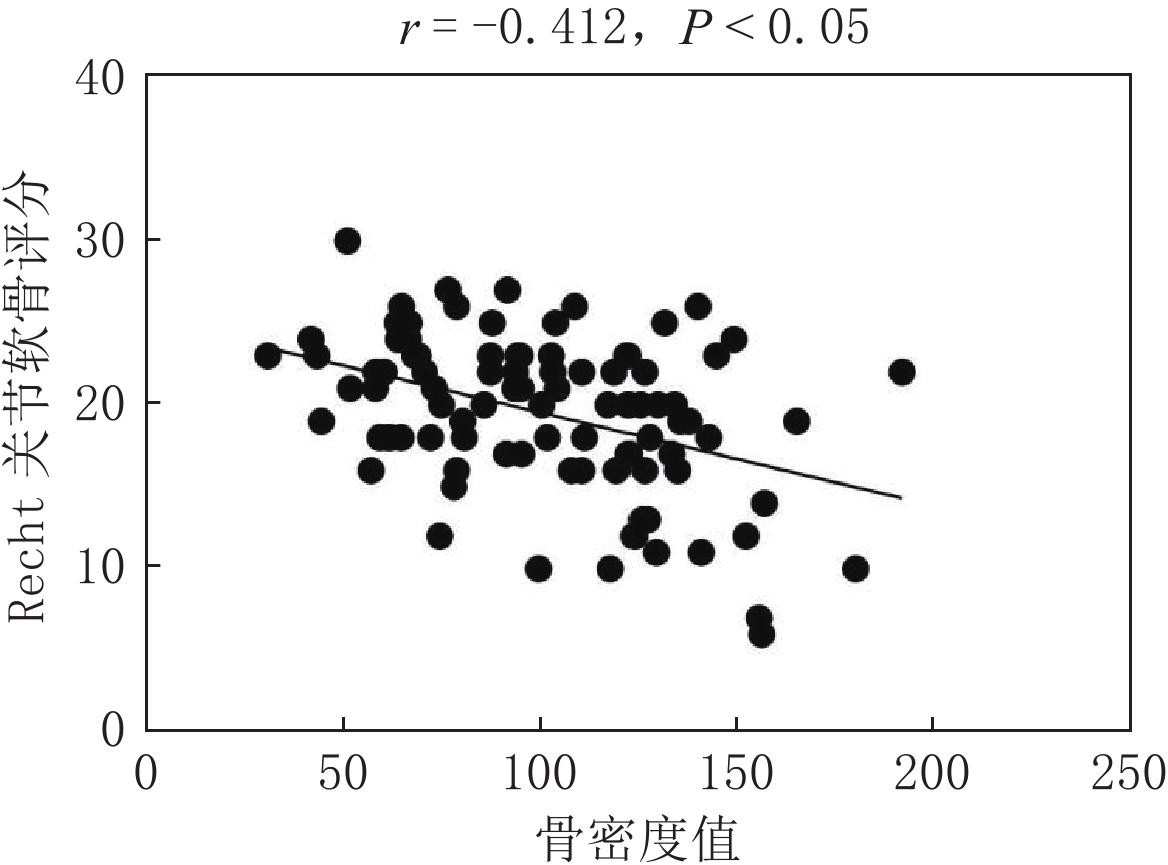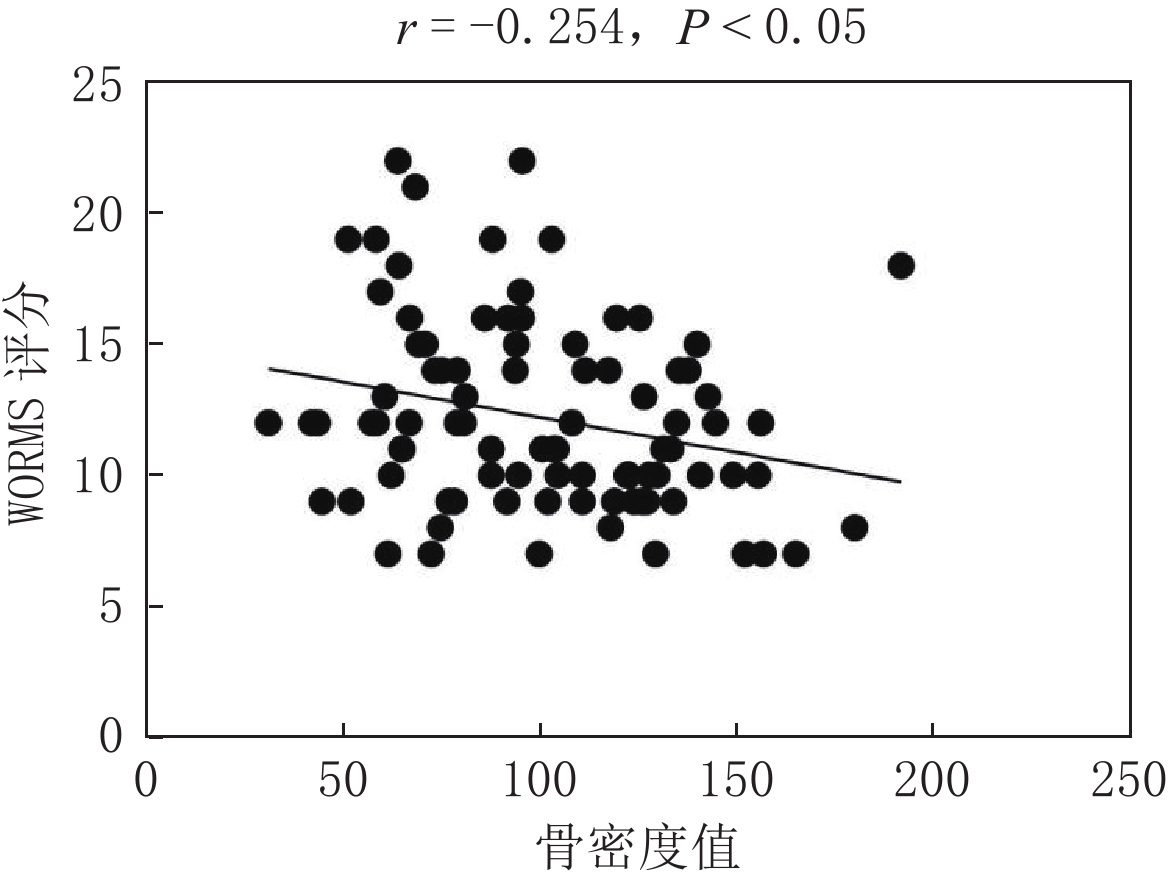Correlation Between MRI Changes and Bone Mineral Density in Patients with Knee Osteoarthritis
-
摘要:
目的:分析探讨膝骨关节炎(KOA)患者软骨损伤、骨髓水肿分别与全身骨密度的关系。方法:选取2023年1月至2023年10月四川省骨科医院收治膝骨关节炎患者90例,均行膝关节MRI及胸部QCT检查。根据QTC结果将患者分为3组:骨密度正常组、骨量减少组、骨质疏松组;同时采集他们的性别、年龄、身体质量指数(BMI)、病程等一般信息。按照Recht关节软骨缺损评分系统、全膝关节磁共振成像评分系统(WORMS)评分分别在膝关节MR上评分,同时收集病例骨密度(BMD),将BMD值与MR软骨缺损评分、骨髓水肿评分做统计学分析。结果:3组的性别、BMI、病程无统计学差异,年龄有统计学差异;3组间的软骨缺损评分及骨髓水肿评分均显示骨量正常组与骨量减少组、骨量正常组与骨质疏松组有统计学意义,骨量减少组与骨质疏松组无统计学意义;KOA软骨损伤与骨密度相关,相关系数r=-0.412;KOA骨髓水肿与骨密度相关,相关系数r=-0.254。结论:KOA患者的全身骨密度值与膝关节软骨损伤、骨髓水肿相关,且全身骨密度减少时,可能提示膝关节软骨损伤程度加重或骨髓水肿程度加重。
Abstract:Objective: To determine the relationship between cartilage injury, bone marrow edema, and total bone mineral density in patients with knee osteoarthritis (KOA). Methods: Ninety patients with KOA admitted to the Sichuan Province Orthopedic Hospital between March 2023 and October 2023 were selected, all of whom underwent knee joint MRI and chest QCT examinations. The patients were divided into three groups according to the QTC results: normal bone density, reduced bone mass, and osteoporosis. Patient information, such as sex, age, body mass index (BMI), and course of illness, was also obtained. MRIs of the knee joints were scored separately according to the Recht grading and Whole-organ Magnetic Resonance Imaging Score (WORMS). The bone mineral density (BMD) of the patients was calculated and the BMD values were statistically analyzed using the MR score. Results: No statistically significant differences were observed in sex, BMI, or disease duration among the three groups; however, a statistically significant difference was observed in age. The Recht and WORMS scores among the three groups showed statistical significance between the normal bone density group and the reduced bone mass and osteoporosis groups; however, no statistical significance was observed between the reduced bone mass and osteoporosis groups. KOA cartilage injury was negatively correlated with bone density with a correlation coefficient of r=−0.412, while KOA bone marrow edema was negatively correlated with bone density with a correlation coefficient of r=−0.254. Conclusion: The total bone density in patients with KOA is related to knee joint cartilage injury and bone marrow edema. A decrease in total bone density may indicate the severity of knee cartilage injury or bone marrow edema.
-
Keywords:
- knee osteoarthritis /
- bone mineral density /
- cartilage injury /
- bone marrow edema /
- osteoporosis
-
索伦-西拉木伦缝合带被认为是中国东北微陆块群与华北克拉通的拼合界限,代表了古亚洲洋最终闭合位置[1-3]。该缝合带中段将中亚造山带东段(含大兴安岭和松嫩地块)与华北克拉通(含燕山造山带)连在一起(图1)。大兴安岭和松嫩地块是古生代古亚洲洋构造域、中生代蒙古-鄂霍茨克洋构造域、以及中新生代环太平洋构造域相关作用叠加最显著的地区[4](图1),华北克拉通东部(含燕山造山带)则以与中新生代环太平洋构造域密切相关的构造作用为主[5-9]。可见,索伦-西拉木伦缝合带南北两侧经历的构造演化有所不同。如今,中国南北重力梯度带贯穿了缝合带两侧,在北部表现为大兴安岭与松辽盆地的盆山转换,在南部为太行山与华北平原的盆山转换[10]。这表明,缝合带南北两侧在较近时期受到了相似的构造改造(图1)。
复杂的构造作用使得索伦-西拉木伦缝合带中段及周边区域不但地表构造复杂,其深部结构也非常复杂。前人在该区大量的二维深部探测研究[11-16]明确了,华北克拉通东北部的岩石圈受到了与中新生代环太平洋俯冲相关的减薄改造。但在此之前的古生代末期,该区曾经历了古亚洲洋的闭合,当时板块聚合的痕迹是否在深部还存在?后续中新生代构造作用对其改造情况如何?显然,只有对区域岩石圈结构的横向和垂向变化特征进行三维揭示,才有助于对这些科学问题的回答。
为解决以上科学问题,本文对索伦-西拉木伦缝合带中段及南北两侧区域进行三维地震面波层析成像,获取该区岩石圈三维横波速度模型,并对该区深部构造特征和成因机制等进行一定的分析。
1. 数据及分析处理
影响面波层析成像可靠性的重要因素包括数据方位分布的均匀性以及面波信号频率含量。数据方位分布越均匀,横向分辨率越好,可靠性越高。高频(短周期)面波信号频率主要分辨浅部,而低频(长周期)可分辨深部。最低信号频率越低(周期越长),垂向探测深度越大。为了提高研究区面波层析成像分辨率和探测深度,我们既对具有低频(长周期)信号特征的地震事件面波波形资料进行分析,也对具有高频(短周期)信号特征的环境噪音面波资料进行了提取。由于可提取的最长周期地震面波信号受制于其最大传播距离(即震中距或台站间距)[17],所以这里以研究区为中心,分析了更大范围内的地震台站记录,以期获得更多长周期面波资料。
本研究主要使用位于华北和东北地区的IRIS共享地震台站、中国地震台阵中心共享的移动地震台站[18](彩色三角)以及中国地震局数据备份中心[19]提供的固定地震台站(黑三角)在2003年至2011年期间的记录的地震波形资料(图2(a))。其中绿三角为中国科学院地质与地球物理研究所2003年以来在华北克拉通北部部署的不同期次的宽频地震探测剖面(NCISP)[20-21];浅蓝三角为2009年至2011年中国地震局地球物理研究所在华北克拉通与兴蒙-吉黑造山带部署的地震观测台阵[22-23];蓝三角为中国地震局与美国和日本联合开展的NECESSArray台阵[24]。由于本文主要利用基阶瑞雷面波群速度作为观测进行三维横波速度层析成像,所以只对垂直分量的面波波形资料进行分析。
对于地震事件面波资料,为了提高数据利用率,并没有单纯依据震级对数据进行筛选,而是同时考虑震级、震中距和信噪比等因素综合对数据进行筛选。在利用环境噪音提取面波格林函数时,我们对研究区内所有连续记录时长不少于1年的降采样波形数据进行台站间互相关计算,提取各台站间的格林函数。在互相关计算之前进行数据预处理[25]:对原始波形剔除仪器响应、去趋势和去平均处理,然后采样率降至1 sps并按每个文件为4 h的时长进行截取;对截取的波形先后进行时间域移动绝对平均均一化(running-absolute-mean normalization)以及频率域白噪化处理对地震事件信号进行了压制。提取到的台站间格林函数在时间域通常表现出一定的对称性,对应于噪音面波的正向和反向传播。这里把正向和反向格林函数的叠加作为台站间平均格林函数。对这些地震事件面波和从环境噪音中提取的台站间格林函数,借助地震学程序包[26]中有关软件,利用多重滤波及相位匹配滤波技术进行面波频散曲线的提取。所有面波频散分析均采用自动处理与人工质量核查相结合的方式,以确保观测数据质量的可靠性。
图3显示了两条相似路径的地震面波和噪音格林函数的时频分析实例。提取到的两条频散曲线具有较高的相似度,但也存在一些差别,两条频散相同周期之间波速的细小差别可能与两者的传播路径长短(即采样区域)不完全一致有关。地震面波频散周期范围(<55 s)略小于噪音格林函数(<70 s),可能与该地震震级不大有关。
密集震群波形可能相互叠加,较近地震或较强噪音也可影响目标事件波形,震中位置可能存在较大偏差,这些因素均可影响面波拾取的可靠性。所以我们计算了所有观测群速度各自周期的均值和标准差σ,然后剔除所有在相应周期两倍标准差(±2σ)之外的观测群速度。
震中距或台站间距不同的观测中提取的面波频散曲线的频率含量不同,所以不同频率(周期)数据在整个研究区的分布也不相同。图2(a)显示周期50 s的观测数据的方位分布玫瑰图。该图显示穿过每个0.3°×0.3° 二维网格内的所有观测数据以每 30° 方位间隔的 50 s观测数据量。图中相应方位扇形半径与数据量成正比,最短半径对应的观测数据量为1,最大半径对应的观测数据量为588,各方位平均观测数量为70。玫瑰图越接近于圆形,该网格点的数据方位分布越均匀(即各个方位均有一定量的观测)。为了避免过密的玫瑰图之间的重叠,图2(a)只抽样显示部分网格点的玫瑰图。由于部分移动观测台站以线状分布且地震多来自于西太平洋俯冲带,致使所有数据中南北和北东方位的观测分布优于北西方位(玫瑰图半径在北西方向偏短),但多数玫瑰图在各个方位均有观测数据。所以研究区观测数据量和方位分布整体较好,为本文的三维层析成像提供了可靠的数据保障。
图2(b)显示了偏差小于两倍标准差的地震事件面波(细黑线)和噪音面波(细灰线)频散曲线及各自平均观测曲线(粗黑线和虚线)。整体而言,周期在5~150 s之间的瑞雷波群速度观测数量比较可观,周期大于100 s的面波观测中地震事件的贡献更大(细黑线多于细灰线),但周期小于40 s的面波观测中环境噪音的贡献更大(细灰线多于细黑线)。地震事件和噪音的平均频散曲线整体相差不大,表明两种观测能较一致地反映区域平均结构,两者细小的差别主要源于环境噪音面波可靠性更好、且采样区域小于地震事件面波采样区域,这样更有助于反映小尺度结构变化。故此本文同时利用地震事件面波和环境噪音面波观测进行三维层析成像,既可以提取可靠的区域平均结构、也可以获取反映更多细节的精细结构。
2. 三维地震面波层析成像方法
面波层析成像反演三维结构通常是先对各周期频散依次进行基于水平离散网格点的二维面波层析成像,以此获得每个离散网格的区域化面波频散;然后分别对各网格的区域化频散曲线进行一维横波速度垂直剖面反演;最后将所有一维横波速度剖面按照二维网格位置拼合成为三维横波速度模型[27-29]。但是由于面波观测对于区域的覆盖通常并不均匀,部分地区观测覆盖密集而其他地区观测覆盖可能比较稀疏,使得面波层析成像反演通常是一个病态反演问题。对于病态反演问题,通常需要引入正则化约束来稳定反演并生成三维空间分布趋于合理的模型参数[30-31]。
但是上述先二维再一维的面波层析成像方法只能先引入横向(水平方向)、再引入纵向(垂直方向)的正则化约束,这可能会引起最终三维模型横向和垂向结构的不协调。所以,我们采用了由Feng等[32]首先提出后经An等[33]和Feng等[34]改进以后的单步直接利用面波频散观测反演三维横波结构的面波层析成像方法,该方法允许同时加入横向和纵向正则化约束以生成具有水平和垂直方向协调的三维横波速度结构模型。此外,该方法还允许使用更接近于真实的三维横波速度参考模型,可以大大降低层析成像反演问题的非线性程度,该方法在三维面波各向异性研究中也已经被成功应用[35]。
地震面波频散观测(群速度或相速度)与横波速度β存在非线性关系,牛顿迭代法是求解非线性方程的重要方法之一,具有二阶收敛性,可以使一个非线性反演仅仅几次迭代迅速收敛至最优解[36],故这里采用牛顿迭代方法。每次迭代中,三维面波层析成像反演问题可以表示为[32]:
$$ \left(\begin{array}{l} {\boldsymbol{d}} \\ {\boldsymbol{0}} \end{array}\right)=\left(\begin{array}{c} {\boldsymbol{G}} \\ \lambda {\boldsymbol{L}} \end{array}\right) \Delta {\boldsymbol{\beta}} \text{,} $$ (1) 其中d是与面波频散相关的观测数据矢量;G是包含面波传播路径和面波与横波速度偏微分等信息的大型稀疏的观测矩阵;Δβ是相对于三维参考模型β0的横波速度扰动矢量,是待求未知量;L是正则化约束矩阵;λ是平衡正则化与观测在反演中权重的系数,这里由Morozov的差异原则来选取[37]。对公式(1)进行反演可以得到横波速度相对于参考模型的扰动Δβ,然后可得反演模型β(=β0+Δβ)。将模型β作为新的参考模型,利用公式(1)进行下一次迭代反演,可以得到更好的解。
层析成像中最常用的正则化约束是使模型参数一阶梯度(经向、纬向和垂向)最小的平坦约束(flatness)[31]。但最新研究表明,当参考模型中存在不可靠不连续面时,平坦约束会阻碍观测对该不可靠结构的矫正[38]。所以这里采用了An[38]建议的基于参考模型的自适应平坦约束L,该正则化约束可以明显改善反演模型中不连续面附近的横波速度结构,更快得到理想结果。一维面波反演测试表明,使用非常差的初始参考模型时,使用普通平坦时需要10多次迭代才能收敛,而自适应平坦约束则只需4次迭代即收敛,且最终结果更接近于真实模型。
越接近于真实的初始三维参考模型可以极大地降低层析成像问题的非线性程度,降低收敛至最优解所需的迭代反演次数。为此我们采用了CRUST 1.0[39]的地壳横波速度和IASP 91[40]的地幔横波速度构建了三维参考模型。由于远震接收函数对于波速界面的敏感性[41]比地震面波优越[42-43],我们依据区域内前人接收函数得到的地壳厚度值[44-46]对参考模型中相应位置的莫霍面上下的壳幔速度进行了调整。
为了确保反演结果不受误差过大观测的影响,在每一次迭代反演之前,我们首先进行先导反演,将拟合误差大于两倍拟合误差均方根的观测去除,然后再进行正式迭代反演。在采用更接近于真实的三维参考模型、可更好改善模型的自适应正则化约束、快速收敛的牛顿迭代方法共同作用下,第2次迭代反演模型相对于第1次迭代反演模型的改善不再显著,所以这里我们采用第2次迭代反演模型作为最终结果。
根据地震面波观测数量、空间分布情况以及周期范围等信息,研究区被离散划分为经向和纬向均为0.3° 间隔的水平网格。考虑到地震面波对横波速度的垂向分辨率随着深度的增加而减弱[47],垂向网格间距设置为随深度增加而增加。深度0~30、30~80、80~200以及200~260 km的垂向网格间距分别为3、5、10和20 km。
3. 分辨率评估
检测板测试是评估层析成像空间分辨率的简单而有效的手段。在检测板测试中,首先创建具有一定结构特征的波速模型,再用实际的观测矩阵G进行正演计算合成理论观测数据;然后在合成数据中加入一定的随机误差并进行反演计算;最后把反演模型与输入模型进行对比,根据给定结构特征的恢复程度来判断观测系统对模型的空间分辨能力。以往二维加一维的分步层析成像方法通常只对不同周期面波进行二维横向分辨率测试,这里采用的单步直接三维层析成像方法则可以同时对横向和垂向分辨率进行检测,所以我们在输入模型中设置了正负波速异常在横向和垂向均交替分布的三维检测板样式(图4),波速异常幅值设为±0.4 km/s。合成数据随机误差幅值取值于真实反演中不同周期的拟合误差(平均约为0.08 km/s)。
不同周期地震面波对横波速度的敏感度(分辨能力)随深度的变化而变化[47],所以这里设置了3组尺寸不同的检测板分别进行了测试,结果见图4。图4(a)显示了检测板异常尺寸在经度、纬度和深度方向上分别为1.2°、1.2° 和15~40 km的输入模型及其反演输出结果。对比15 km深度的水平切片的输入与输出模型,可以看出反演模型很好地恢复了检测板样式,表明反演模型在该深度对该尺寸异常具有可靠分辨率。
从剖面1−1'垂直切片来看,反演模型在60 km及以下深度的分辨率变得非常有限(图4(a)剖面1−1'虚线之下的部分)。可见反演模型在地壳内部对尺寸为1.2°×1.2°×(15~40 km)的异常具有较可靠的分辨率。图4(b)所示的检测板异常尺寸为1.8°×1.8°×(20~60 km),略大于图4(a)所示检测板异常尺寸。深度30 km的水平切片和剖面2−2'的垂直切片显示,反演模型在约100 km以上(图4(b)剖面2−2'虚线之上的部分)对该尺寸异常有较可靠的分辨率。而当检测板异常尺寸进一步加大至2.4°×2.4°×(30~70 km)时(图4(c)),深度80 km的水平切片上的检测板能被很好地恢复。剖面3−3'的垂直切片上的检测板形态虽然在深部被一定程度地扭曲,但正负相间的分布特征直到160 km深度依然能被较好地恢复。所以反演模型对于尺寸为2.4°×2.4°×(30~70 km)的异常的分辨率可延伸至160 km深度。
对比图4三组不同异常尺寸的检测板测试结果可以看出,反演模型的空间分辨率随深度的增加而减小。此外,3组测试的垂直剖面结果还显示,反演结果对输入模型异常幅值存在不同程度的低估(即比输入模型异常幅值偏小),而且低估程度随深度的增加而加重。所以在后续反演结果的讨论中,我们将侧重关注波速异常极性(正或负)的空间分布,而不是波速异常绝对值大小。
4. 结果及讨论
图5显示实际反演得到的三维横波速度模型在9、35、80和120 km深度的水平切片。由于面波自身特性和垂向平坦正则化的作用,反演模型中一个深度的波速也包含了一定的相邻深度的信息。研究区内的渤海湾盆地和松辽盆地分别为新生代和中生代沉积盆地[48],沉积物厚达10 km[49],所以图5(a)中9 km深度横波速度异常形态分布主要反映沉积层在横向分布的变化。沉积物通常比基岩表现出更低的横波速度[50],所以低速越强表明沉积更厚。
从图5(a)波速切片可以看出,最低的速度(红色)集中分布在松辽盆地东北部(松嫩地块),下辽河盆地和渤海湾盆地,而且整体呈北东向条带状分布。盆地的沉积分布走向与盆地两侧的大兴安岭、太行山和辽东隆起(长白山)的走向基本平行,也与西太平洋俯冲前缘基本平行。暗示该区地壳浅部结构可能与西太平俯冲的直接或远程作用相关。
研究区平均地壳厚度介于30~40 km之间[12,23,44-46,51-52],所以图5(b)中35 km横波波速切片主要反映下地壳或上地幔顶部结构,其中,高速可能意味着该位置处于地幔中,而低速意味着仍处于地壳中,或者说,波速高值(蓝色)指示地壳厚度偏薄,波速低值(绿色)指示地壳厚度偏厚。图5(b)的典型特征是,整个松辽盆地和下辽河盆地的波速高于其西侧的大兴安岭和燕山造山带,表明负地形的松辽盆地和下辽河盆地地壳厚度比大兴安岭和燕山造山带薄,或者说,地壳底界面与地形基本呈镜像关系。这表明该地区的地壳大体处于重力均衡状态。但研究区东南地区却有所不同,比如辽东隆起虽然地形偏高但波速也偏高(地壳可能偏薄),而渤海湾盆地虽然地形很低但波速也偏低(地壳偏厚),即暗示这两个地区地壳尚未达到重力均衡状态,这可能意味着对渤海湾和辽东隆起的最后一次构造改造较晚且较强,致使地壳尚未调整到均衡状态。此外,该深度波速异常形态仍然以北东向展布为特征,与9 km深度所反映的上地壳顶部波速展布特征相似,表明研究区整个地壳由浅及深均受到同一个动力环境的较彻底的改造。
地震热学[53]和地震 S波接收函数[12,22,54]研究结果显示研究区岩石圈厚度横向变化显著,基本介于70~200 km之间,所以80 km和120 km深度横波速度切片主要反映岩石圈上地幔结构。在上地幔中,岩石圈物质通常表现出比软流圈物质更高的波速,所以这两个深度的高速和低速分别指示处于岩石圈和软流圈之中。对于同一深度而言,高速越强指示岩石圈强度越大(或岩石圈越厚),反之越弱(或岩石圈越薄)。80 km深度切片(图5(c))显示索伦-西拉木伦缝合带北侧沿大兴安岭与松嫩地块之间的盆山转换带存在非常明显的北东向展布高速带,预示该区岩石圈较强或者较厚,及该区域上地幔可能经历了与地壳相关的北东向构造改造。
但研究区中的华北克拉通部分在该深度并没有表现出稳定克拉通所具有的横向均匀分布的高速特征,却表现出复杂的异常分布特征,不但在渤海湾盆地和下辽河盆地表现出了相对低速特征,而且在索伦-西拉木伦缝合带以南地区(华北克拉通东北部及华北北缘增生带)的高速体均呈边界模糊的块状分布,不再具有明显的北东向展布特征。这表明华北克拉通东北部及其北缘增生带的上地幔强度或岩石圈厚度存在明显横向不均匀性,且上地幔与地壳可能经历了程度不同的构造变形和改造。到120 km深度,研究区的高速主要以成片的形式分布在索伦-西拉木伦缝合带以南地区,且该高速片区的北边界几乎与索伦-西拉木伦缝合带的东西走向一致。表明该深度上地幔的构造展布特征与西太平洋俯冲体系相关的近北东向展布的特征完全不同,暗示华北北缘增生带及其附近上地幔在中新生代的改造可能不彻底,致使仍保留了部分古生代末期古亚洲洋闭合时的构造形态或痕迹。
图6(a)显示了3条垂直于主要构造线的南北向剖面(1−1',2−2'和 3−3')的横波速度垂向切片。由南向北,3条剖面均依次穿过了燕山造山带,华北北缘增生带(AB),索伦-西拉木伦缝合带(SXS),大兴安岭或松嫩地块。如果以3.3 km/s等速线代表与沉积相关的低速层底界面,那么图6(a)各剖面中低速层分布与研究区主要沉积盆地对应良好。依据低速层的厚度可以看出渤海湾盆地具有最厚的沉积覆盖物(剖面1−1'和 2−2'),其次是下辽河盆地(剖面3−3'),松辽盆地西部沉积相对最薄(剖面3−3')。此外,新沉积物的压实和固结成岩效果一般比老沉积物差,所以新沉积物通常比老沉积物具有更低的横波速度。而图6(a)显示的新生代勃海湾盆地沉积层的低速强度的确比中生代松辽盆地大,证实我们成像结果的合理性和可靠性。
接收函数得到的台站下方莫霍面位置大致与本文三维模型中的4.2 km/s等速面深度接近。如果以该等速面作为地壳与地幔的分界面,那么图6(a)中3条剖面穿过区域的莫霍面起伏并不显著,地壳厚度大致在31~35 km之间变化,这与前人通过接收函数提取的区域地壳厚度在30~40 km之间变化的结果基本吻合[12,23,44-46,51-52]。图6(a)所示的地壳厚度的细小变化也呈现出一些区块特征,比如剖面2−2'显示地形最低的渤海湾盆地的地壳厚度在各自的剖面上不仅不是最薄的,反倒是最厚的,最厚处几乎达到了约40 km。在地形较高的辽东隆起的地壳厚度并不厚,与区域平均的33 km基本持平(剖面3−3')。这意味着渤海湾盆地和辽东隆起这两个区域的地壳尚未达到重力均衡状态,即该区可能经历了较近的构造改造。图6(a)中黑色圆圈表示1964年以来EHB目录中在该区的地震震中[55]。地震的发生是对区域构造活动或岩石圈变形调整的直接反映。图6(a)中地震主要发生在渤海湾盆地和辽东隆起附近,且部分地震发生在深部的岩石圈上地幔内,证实该区正在经历岩石圈尺度的构造改变,这与我们通过层析成像结果得出的该区正在经历或经历过较新的构造改变的结论非常吻合。
图6(a)中各剖面地壳以下的上地幔波速表现出明显的分段和分层特征。从岩石圈向软流圈过渡地震波速会明显下降,所以岩石圈地幔中最大波速负梯度所在深度通常被当作地震学岩石圈与软流圈分界面(LAB)[56-57];也有部分研究采用经验波速值的等速面对LAB进行定义[58-59]。如果将最大负梯度(与图中4.4 km/s等速面位置接近)看作岩石圈与软流圈边界的话,可以看出研究区内岩石圈形态横向变化非常剧烈。西部的剖面1−1'的上地幔从南向北表现为特征明显不同的3段,南段以渤海湾盆地为主,北段以大兴安岭为主;南段的渤海湾盆地之下除了具有速度很高、延伸到深度约75 km的岩石圈以外,还在130~200 km深度之间存在一个与上层岩石圈分离的高速体。
虽然华北克拉通东部(含渤海湾盆地)古老岩石圈在显生宙被破坏并形成了华北裂谷盆地,但燕山地区却并不是裂谷盆地且地表有大片太古代岩石出露[60-61]。在130~200 km显示的高速特征更进一步说明,其岩石圈被破坏的程度可能远不及华北盆地,故此,我们推测下层高速体可能与古老华北克拉通岩石圈残余相关。从整个剖面来看,渤海湾之下的上地幔高速非常强,即可能存在比周围区域密度较高的岩石。鉴于此,上文提及渤海湾浅部结构并未达到重力均衡,那么有可能部分均衡来自于岩石圈地幔。
剖面1−1'的中段包括燕山造山带北部到索伦-西拉木伦缝合带(SXS)附近。在该段多数区域莫霍之下的波速值比南北两段低,在约70~120 km才表现为更明显的高速。从该段整体来看,该高速层呈现以索伦-西拉木伦缝合带(SXS)为起点,明显向南俯冲,然后在赤峰-开原断裂(CKF)附近转变成近水平展布。赤峰-开原断裂被认为是华北克拉通北部边界,再考虑到上文(地幔波速水平切片)结果支持华北北缘增生带及其附近上地幔可能仍保留了部分古生代末期古亚洲洋闭合时的构造形态或痕迹,故此推测具有南向俯冲形态的高速层可能反映古亚洲洋俯冲板片残余,而赤峰-开原断裂以南的燕山造山带下方的近水平高速层可能是华北克拉通岩石圈。
在剖面1−1'北段(大兴安岭),地幔中以4.4 km/s等速线圈定的高速层非常薄,但其下方整体呈现出弱高速,可能表明该区岩石圈整体偏厚但强度偏弱。中国岩浆岩分布图[48]显示大兴安岭有大量古生代和中生代岩浆岩出露,但新生代岩浆岩较缺乏,意味着该区最后一次强烈构造活动可能发生在中生代而不是新生代。那么该区强度偏弱的高速上地幔可能与中生代古亚洲洋和蒙古鄂霍茨克洋俯冲及板片残余有关。
位于研究区中部的剖面2−2'显示了一些与剖面1−1'相似的特征。渤海湾盆地同样具有速度很高、延伸深度约75 km的高速岩石圈。在燕山造山带和华北北缘增生带下方约120~160 km深度存在两个与上层岩石圈分离的高速体,该高速体强度略弱于上层高速层。而以索伦-西拉木伦缝合带为界,其北侧的大兴安岭之下高速层厚度达120 km。燕山造山带属于华北克拉通,其下方的高速块体与剖面1−1'中类似,可能反映华北克拉通岩石圈残余。而位于索伦-西拉木伦缝合带以南华北北缘增生带之下的高速体则既可能反映华北克拉通残余,也可能与古亚洲洋俯冲板片残余有关。剖面北侧大兴安岭较厚的高速层可能意味着该区岩石圈没有受到像索伦-西拉木伦缝合带以南地区那样强烈的岩石圈构造破坏作用。
位于研究区东部的剖面3−3'普遍存在一层延伸至至少约75 km深度的高速层,该高速层底界面只在辽东隆起和剖面最北端出现了起伏,该剖面最北端,即松嫩地块与大兴安岭盆山转换带附近,高速层起伏与地表地形呈镜像关系,暗示该盆山转换带附近处于重力相对均衡的状态。该盆山转换带在剖面2−2'也呈现类似形态,这意味着,中国最典型的南北重力梯度带东北部分多处于相对均衡、构造相对稳定的状态。该剖面另一个典型的特征是在辽东隆起和华北北缘增生带下方存在两个与上覆高速层尚未完全分离的高速体,形成一种岩石圈正在被破坏或发生分离的影像。辽东隆起隶属于华北克拉通,所以该区下沉的高速体可能反映正在被破坏/减薄的华北克拉通,而华北北缘增生带下方正在被拆离的高速体规模明显比辽东半岛下方的大,它可能既包含华北克拉通岩石圈,也包含古亚洲洋俯冲板片残余。
图6(b)显示了3条平行于主要构造线的东西向剖面(4−4',5−5'和6−6')的横波速度垂向切片。3条剖面显示区域岩石圈结构同样存在明显的东西向变化,而且与南北向剖面呈现稳定一致的结构特征,包括:渤海湾盆地之下可能与华北克拉通岩石圈残余相关的深层高速体;辽东隆起下方正在被改造的厚而弱的岩石圈;下辽河盆地下方约75 km厚的高速岩石圈等等。
考虑到中国东北和华北的岩石圈被中生代以来由太平洋俯冲触发的大规模热侵蚀不同程度地破坏,以上上地幔深部结构明显的横向差异则表明,由太平洋俯冲引发的热侵蚀作用存在明显的横向不均匀性。
5. 结论
索伦-西拉木伦缝合带中段及周边区域面波层析成像结果显示,研究区横波速度在地壳和80 km以上的岩石圈上地幔多以北东向条带状分布,而在80 km深度以下,则以与索伦-西拉木伦缝合带走向近似平行的东西向展布。这表明,华北北缘增生带及其附近上地幔在中新生代的改造可能不彻底,致使仍保留了部分古生代末期古亚洲洋闭合时的构造形态或痕迹。
以索伦-西拉木伦缝合带为界,其南侧的上地幔岩石圈相对复杂,而北侧却相对均匀。在该缝合带南侧各地区中,渤海湾盆地、燕山造山带和大兴安岭与燕山造山带之间的华北北缘增生带的上地幔复杂程度大于辽东隆起、松嫩地块与下辽河盆地之间的华北北缘增生带。
以往研究表明中国东北和华北的岩石圈被中生代以来由太平洋俯冲触发的大规模热侵蚀不同程度地破坏。本研究结果显示,以索伦-西拉木伦缝合带为界的南北两侧所经受的破坏程度不同,而南侧区域内部,其东西也不同。这说明了由太平洋俯冲触发的热侵蚀作用存在明显的横向不均匀性。
-
表 1 三组骨关节炎患者一般资料比较
Table 1 Comparison of the general data of patients with osteoarthritis in the three groups
组别 年龄$ \left(\overline{x}\pm s\right) $/岁 性别/例 BMI$ \left(\overline{x}\pm s\right) $/kg·m-2 病程$ \left(\overline{x}\pm s\right) $/月 男 女 骨量正常组(n=30) 55.03±7.42 7 23 26.20±3.68 44.23±71.20 骨量减少组(n=30) 62.30±10.11 8 22 26.03±3.92 61.47±72.39 骨质疏松组(n=30) 68.80±6.69 3 27 25.65±3.29 50.83±55.45 检验值 F=21.139 $\chi^2 $=2.917 F=0.184 F=0.508 P 0.000 0.233 0.832 0.603 表 2 三组骨关节炎患者软骨评分比较
Table 2 Comparison of the cartilage scores of patients with osteoarthritis in the three groups
组别 项目 统计检验 骨量正常组(n=30) 骨量减少组(n=30) 骨质疏松组(n=30) F P 得分$ \left(\overline{x}\pm s\right) $ 17.10±5.25 20.10±4.04 21.33±3.98 7.143 0.01 表 3 三组骨关节炎患者骨髓水肿评分比较
Table 3 Comparison of the bone marrow edema scores of patients with osteoarthritis in the three groups
项目 组别 统计检验 骨量正常组(n=30) 骨量减少组(n=30) 骨质疏松组(n=30) F P 得分$ \left(\overline{x}\pm s\right) $ 10.73±2.74 12.83±3.67 13.03±3.99 3.941 0.023 -
[1] 王斌, 邢丹, 董圣杰, 等. 中国膝骨关节炎流行病学和疾病负担的系统评价[J]. 中国循证医学杂志, 2018, 18(2): 134−142. WANG B, XING D, DONG S J, et al. Prevalence and disease burden of knee osteoarthritis in China: A systematic review[J]. Chinese Journal of Evidence-based Medicine, 2018, 18(2): 134−142. (in Chinese).
[2] HARRELL C R, MARKOVIC B S, FELLABAUM C, et al. Mesenchymal stem cell-based therapy of osteoarthritis: Current knowledge and future perspectives[J]. Biomedicine Pharmacotherapy, 2019, 109: 2318−2326. DOI: 10.1016/j.biopha.2018.11.099.
[3] MESSENT E A, WARD R J, TONKIN C J, et al. Differences in trabecular structure between knees with and without osteoarthritis quantified by macro and standard radiography, respectively[J]. Osteoarthritis Cartilage, 2006, 14(12): 1302−1305. DOI: 10.1016/j.joca.2006.07.012.
[4] BUCKLAND-WRIGHT C. Subchondral bone changes in hand and knee osteoarthritis detected by radiography[J]. Osteoarthritis Cartilage, 2004, 12(S)A: S10-S19.
[5] DEDRICK D K, GOLDSTEIN S A, BRANDT K D, et al. A longitudinal study of subchondral plate and trabecular bone in cruciate-deficient dogs with osteoarthritis followed up for 54 months[J]. Arthritis Rheumatic, 1993, 36(10): 1460−1467. DOI: 10.1002/art.1780361019.
[6] 张程, 吴忠书, 李子祺, 等. 膝骨关节炎与骨质疏松症的相关性研究进展[J]. 中国骨质疏松杂志, 2021, 27(4): 618−624. DOI: 10.3969/j.issn.1006-7108.2021.04.028. ZHANG C, WU Z S, LI Z Q, et al. Research progress on the correlation between knee osteoarthritis and osteoporosis[J]. Chinese Journal of Osteoporosis, 2021, 27(4): 618−624. DOI: 10.3969/j.issn.1006-7108.2021.04.028. (in Chinese).
[7] BENNELL K L, CREABY M W, WRIGLEY T V, et al. Bone marrow lesions are related to dynamic knee loading in medial knee osteoarthritis[J]. Annals of the Rheumatic Diseases, 2010, 69(6): 1151−1154. DOI: 10.1136/ard.2009.118182.
[8] 王勇朋, 阳琰, 何生生, 等. 低剂量胸部CT与QCT椎体骨密度测量一站式扫描可行性研究[J]. 放射学实践, 2018, 33(11): 1194−1197. WANG Y P, YANG Y, HE S S, et al. Low-dose chest CT and QCT “one-stop-shop” scan technology: A feasibility study[J]. Radiologic Practice, 2018, 33(11): 1194−1197. (in Chinese).
[9] 中华医学会骨科学分会关节外科学组. 骨关节炎诊疗指南(2018年版)[J]. 中华骨科杂志, 2018, 38(12): 705−715. DOI: 10.3760/cma.j.issn.0253-2352.2018.12.001. Osteoporosis Group of Chinese Orthopaedic Associationg. Chinese guideline for diagnosis and management of osteoarthritis (2018 edition)[J]. Chinese Journal of Orthopaedics, 2018, 38(12): 705−715. DOI: 10.3760/cma.j.issn.0253-2352.2018.12.001. (in Chinese).
[10] RECHT M P, KRAMER J, MARCELIS S, et al. Abnormalities of articular cartilage in the knee: Analysis of available MR techniques[J]. Radiology, 1993, 187(2): 473−478. DOI: 10.1148/radiology.187.2.8475293.
[11] PETERFY C G, GUERMAZI A, ZAIM S, et al. Whole-organ magnetic resonance imaging score (WORMS) of the knee in osteoarthritis[J]. Osteoarthritis Cartilage, 2004, 12(3): 177−190. DOI: 10.1016/j.joca.2003.11.003.
[12] 李凯, 陈捷, 赵林芬, 等. 中国人群定量CT(QCT)脊柱骨密度正常参考值的建立和骨质疏松症QCT诊断标准的验证[J]. 中国骨质疏松杂志, 2019, 25(9): 1257−1262. DOI: 10.3969/j.issn.1006-7108.2019.09.011. LI K, CHEN J, ZHAO L F, et al. The establishment of QCT spinal vBMD re ference database and the validation of the diagnosis criteria of oste oporosis with QCT for Chinese[J]. Chinese Journal of Osteoporosis, 2019, 25(9): 1257−1262. DOI: 10.3969/j.issn.1006-7108.2019.09.011. (in Chinese).
[13] 舒意, 杨沛, 廖紫祾, 等. 一站式低剂量扫描在胸部及腰椎QCT体检人群中的应用[J]. CT理论与应用研究, 2022, 31(2): 244−250. DOI: 10.15953/j.1004-4140.2022.31.02.12. SHU Y, YANG P, LIAO Z L, et al. To explore the low-dose CT and QCT “one-stop-shop” scan technology for physical examination crowd[J]. CT Theory and Applications, 2022, 31(2): 244−250. DOI: 10.15953/j.1004-4140.2022.31.02.12. (in Chinese).
[14] 赵敏, 刘鸿雁, 王国华, 等. 膝关节骨关节炎半月板损伤程度与关节软骨T1 rho、T2 mapping相关性研究[J]. 中国临床医学影像杂志, 2019, 30(11): 812−816. ZHAO M, LIU H Y, WANG G H, et al. The correlation between the degree of meniscus injury of knee osteoarthritis and T1 rho, T2 mapping of the articular cartilage[J]. Journal of China Clinic Medical Imaging, 2019, 30(11): 812−816. (in Chinese).
[15] 王佳, 朱吉云, 茅博伟, 等. 膝关节骨性关节炎软骨损伤的MRI形态评分及T2值变化与临床表现的相关性[J]. 影像研究与医学应用, 2021, 5(21): 26−27. DOI: 10.3969/j.issn.2096-3807.2021.21.012. WANG J, ZHU J Y, MAO B W, et al. MRI morphological scores of cartilage injury in knee joint osteoarthritis and correlation between changes of T2 value and clinical features[J]. Journal of Imaging Research and Medical, 2021, 5(21): 26−27. DOI: 10.3969/j.issn.2096-3807.2021.21.012. (in Chinese).
[16] 刘艳平, 廖忠剑, 李正南. 磁共振成像检查在评估膝关节退行性骨关节炎患者关节损伤程度中的价值[J]. 中国当代医药, 2021, 28(34): 158−161. DOI: 10.3969/j.issn.1674-4721.2021.34.043. LIU Y P, LIAO Z J, LI Z N. The value of magnetic resonance imaging in assessing the degree of joint damage in patients with knee degenerative osteoarthritis[J]. China Modern Medicine, 2021, 28(34): 158−161. DOI: 10.3969/j.issn.1674-4721.2021.34.043. (in Chinese).
[17] 韩雪莉. 迭代模型重建技术在低剂量胸部CT联合腰椎QCT扫描中的研究[D]. 郑州: 郑州大学, 2018. HAN X L. The study of iterative model reconstruction technique on the low dose chest CT combined with lumbar vertebrae quantitative CT[D]. Zhengzhou: Zhengzhou University, 2018. (in Chinese).
[18] LEE J Y, HARVEY W F, PRICE L L, et al. Relationship of bone mineral density to progression of knee osteoarthritis[J]. Arthritis Rheumatic, 2013, 65(6): 1541−1546. DOI: 10.1002/art.37926.
[19] BOBINAC D, SPANJOL J, ZORICIC S, et al. Changes in articular cartilage and subchondral bone histomorphometry in osteoarthritic knee joints in humans[J]. Bone, 2003, 32(3): 284−290. DOI: 10.1016/S8756-3282(02)00982-1.
[20] KAMIBAYASHI L, WYSS U P, COOKE T D, et al. Trabecular microstructure in the medial condyle of the proximal tibia of patients with knee osteoarthritis[J]. Bone, 1995, 17(1): 27−35. DOI: 10.1016/8756-3282(95)00137-3.
[21] LI B, ASPDEN R M. Composition and mechanical properties of cancellous bone from the femoral head of patients with osteoporosis or osteoarthritis[J]. Journal of Bone and Mineral Research, 1997, 12(4): 641−651. DOI: 10.1359/jbmr.1997.12.4.641.
[22] TOKGÖZ M A, ATIK O Ş, ESENDAĞLI G, et al. Is it possible that the pathogenesis of osteoarthritis could start with subchondral trabecular bone loss like osteoporosis?[J]. Eklem Hastalik Cerrahisi, 2018, 29(3): 152−158. DOI: 10.5606/ehc.2018.007.
[23] MARCUCCI G, BRANDI M L. Rare causes of osteoporosis[J]. Clinical Cases in Mineral and Bone Metabolism, 2015, 12(2): 151−156.
[24] RYD L, BRITTBERG M, ERIKSSON K, et al. Pre-osteoarthritis: Definition and diagnosis of an elusive clinical entity[J]. Cartilage, 2015, 6(3): 156−165. DOI: 10.1177/1947603515586048.
[25] WEN L, SHIN M H, KANG J H, et al. The relationships between bone mineral density and radiographic features of hand or knee osteoarthritis in older adults: Data from the Dong-gu study[J]. Rheumatology (Oxford), 2016, 55(3): 495−503.
[26] ROEMER F W, NEOGI T, NEVITT M C, et al. Subchondral bone marrow lesions are highly associated with, and predict subchondral bone attrition longitudinally: The MOST study[J]. Osteoarthritis Cartilage, 2010, 18(1): 47−53. DOI: 10.1016/j.joca.2009.08.018.
[27] DORE D, MARTENS A, QUINN S, et al. Bone marrow lesions predict site-specific cartilage defect development and volume loss: A prospective study in older adults[J]. Arthritis Research Therapy, 2010, 12(6): R222. DOI: 10.1186/ar3209.
[28] de SÁ G A, DOS S A, NOGUEIRA J M, et al. Angiotensin II triggers knee joint lesions in experimental osteoarthritis[J]. Bone, 2021, 145: 115842. DOI: 10.1016/j.bone.2021.115842.
[29] HEILMEIER U, WAMBA J M, JOSEPH G B, et al. Baseline knee joint effusion and medial femoral bone marrow edema, in addition to MRI-based T2 relaxation time and texture measurements of knee cartilage, can help predict incident total knee arthroplasty 4~7 years later: Data from the Osteoarthritis Initiative[J]. Skeletal Radiology, 2019, 48(1): 89−101. DOI: 10.1007/s00256-018-2995-4.
[30] 曾国庆, 董铿, 黄建军. 膝骨关节炎与骨质疏松症的相关性分析[J]. 中国卫生标准管理, 2023, 14(18): 94−97. DOI: 10.3969/j.issn.1674-9316.2023.18.022. ZENG G Q, DONG K, HUANG J J. Analysis of the correlation between knee osteoarthritis and osteoporosis[J]. China Health Standard Management, 2023, 14(18): 94−97. DOI: 10.3969/j.issn.1674-9316.2023.18.022. (in Chinese).
[31] 周自明, 常时新, 田芳, 等. 膝骨关节炎软骨下骨髓水肿样及囊样病变与软骨病损的相关性研究[J]. 中国医学计算机成像杂志, 2012, 18(3): 243−248. DOI: 10.3969/j.issn.1006-5741.2012.03.012. ZHOU Z M, CHANG S X, TIAN F, et al. Relationship between subchondral bone marrow edema-like or cyst-like lesions and cartilage loss in patients with knee osteoarthritis[J]. Chinese Computed Medical Imaging, 2012, 18(3): 243−248. DOI: 10.3969/j.issn.1006-5741.2012.03.012. (in Chinese).
[32] 何勇, 张乾, 高华利, 等. 类风湿关节炎膝关节骨髓水肿病变的影像学研究[J]. 中国矫形外科杂志, 2019, 27(5): 421−425. HE Y, ZHANG Q, GAO H L, et al. Bone marrow edema in rheumatoid arthritis knee: A study based on MRI[J]. Orthopedic Journal of China, 2019, 27(5): 421−425. (in Chinese).
[33] 肖龙文, 桑志成. 重度膝骨关节炎患者骨髓水肿与骨质疏松的相关性研究[J]. 中国骨伤, 2023, 36(4): 371−375. XIAO L W, SANG Z C. Study on correlation between bone marrow edema and osteoporosis in patients with severe knee osteoarthritis[J]. China Journal of Orthopaedics and Traumatology, 2023, 36(4): 371−375. (in Chinese).
[34] 郭子瑊, 毛兴佳, 高英杰, 等. 膝骨关节炎与膝关节周围骨密度的相关性研究进展[J]. 中华关节外科杂志(电子版), 2021, 15(5): 586−595. GUO Z J, MAO X J, GAO Y J, et al. Research progress on relationship between knee osteoarthritis and bone mineral density around knee joint[J]. Chinese Journal of Joint Surgery (Electronic Edition), 2021, 15(5): 586−595. (in Chinese).
[35] 程晓光, 王亮, 曾强, 等. 中国定量CT(QCT)骨质疏松症诊断指南(2018)[J]. 中国骨质疏松杂志, 2019, 25(6): 733−737. CHENG X G, WANG L, ZENG Q, et al. The China guideline for the diagnosis criteria of osteoporosis with quantitative computed tomography (QCT) (2018)[J]. Chinese Journal of Osteoporosis, 2019, 25(6): 733−737. (in Chinese).
[36] ENGELKE K, ADAMS J E, ARMBRECHT G, et al. Clinical use of quantitative computed tomography and peripheral quantitative computed tomography in the management of osteoporosis in adults: The 2007 ISCD official positions[J]. Journal of Clinical Densitometry, 2008, 11(1): 123−162. DOI: 10.1016/j.jocd.2007.12.010.
-
期刊类型引用(1)
1. 倪晓龙,周凤云,施政,马永忠,程晓光. 基于剂量模拟人的腹部CT扫描辐射剂量分布研究. CT理论与应用研究. 2024(06): 808-814 .  本站查看
本站查看
其他类型引用(0)




 下载:
下载:











